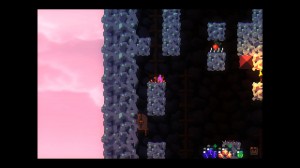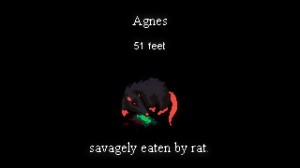Tower Climb has been a game that I’ve been keeping an eye on since I first heard about it. A recent sale prompted me to finally try it out and what we have is an interesting mix of rogue-like and platformer design wrapped up in an old-school pixel aesthetic. Don’t let the cute graphics fool you however, this is a brutal game and is not for everybody.
Going Up:
Tower Climb’s story is about a mysterious tower that beckons people to attempt to climb it, with no one yet reaching the top. You of course play one of many, many, many, people who are attempting to climb this thing to find out what’s inside. Each floor of the tower is procedurally generated based on the section you’re in; this determines enemies, environmental obstacles and possible items and events that may show up.
As a platformer, your actual options during play are limited to movement-based abilities. You can run, jump, climb up and down walls and hang from ceilings. As with the case of climbing up a tower, if you fall too far you will die, forcing you to properly plan your ascent. If you get high enough in the tower, you’ll unlock the next chapter which essentially acts as a progression point.
The rogue-like nature of the design comes in with how the game is a lot more cerebral than your typical platformer. You can find and pick up items in the tower that can be used or stored in your inventory. These items offer a lot of different effects and can also be used in a pinch as a makeshift way of double jumping, by throwing the item down while you’re in midair.
Enemies are present on every floor and all it takes is one hit to kill you for the most part. In order to get around them, you’ll need to make use of your items and what amounts to your trump cards: Magic potions that you start the game with. At the start of a run, (or should I say climb,) you are given three types of potions: Jump potions that let you double jump once per drink, corrosive potions that blow up parts of the tower and enemy alike, and teleporting potions that let you move to almost anywhere on screen.
These potions are of a limited quantity and you can only replenish them by finding golden berries and buying more from a witch who appears at random points during a play.
One final potion which is special, is the revive potion. If you die while having a revive potion in your inventory, you’ll be brought back to life and given a few seconds of invincibility. The catch is that you can only carry one at a time on normal difficulty and they’re the most expensive potion to buy.
Tower Climb is a very challenging game; you’re always one mistake from dying and restarting back at the bottom of the tower (or from a chapter save.) My main problem though with the game has to do with the mix of platformer and rogue-like design.
Going Down:
Tower Climb is a rogue-like with platforming elements and not a platformer with rogue-like elements, it may not sound all that different, but that’s a big part of the problem with the game for me.
As mentioned, all the levels are procedurally generated as you enter a new floor and unfortunately they’re not generated a lot of times with a way up. There are going to be plenty of times where the game will generate a layout that you simply cannot get up by your own skills; you’ll have to use your limited supply of potions or use an item you picked up as a makeshift boost. This downplays the platforming aspect of the game and makes the procedurally generated layouts a lot more punishing. If you get a few layouts that force you to use all your potions, you may end up stuck and unable to progress further.
As a counter example, Spelunky also features procedurally generated level layouts and a similar design philosophy of tying enemies and situations to different areas. The big difference is that Spelunky’s engine was programmed to create a way from the start to the end of the level that the player can go through. Items in Spelunky are there to supplement your platforming ability, not be required. I can get through a level without using ropes and bombs; will it be harder? Yes, but it’s doable.
In Tower Climb, you are required to use your potions and items, and if you can’t find berries or the witch to restock, you will lose and there will be nothing that you can do to avoid it. This to me makes Tower Climb a bit cheap in its rogue-like design and can be a deal breaker for people looking for the next Spelunky.

Level generation is a huge factor in terms of difficulty due to how they can be a drain on your resources.
Another issue with Tower Climb is that despite the simply structure of the game, it’s very button-heavy. Trying to play the game with just the keyboard as default, I found it very annoying and it didn’t play right to me.
The reason is that when you combine movement with inventory management and using items, the keyboard is very awkward to play. For instance, you can’t hold down the run button and use a jump potion for some reason; yet it works with the other potions.
Also, the act of running, jumping over a pit and then throwing an item down to boost is very hard to pull off as you can’t let go of an item while holding down run and it makes things needlessly complicated. If you’re going to play Tower Climb, I strongly suggest using a gamepad and modifying the controls to fit it.
Reach the Top:
Tower Climb is a unique game; the combination of rogue-like and platformer elements is sure to give you hours of climbing, falling and dying in brutal ways. As I said, the game crosses that line in my opinion between challenging and frustrating due to the current balance between rogue-like and skill-based platforming. If you’re looking for the next Spelunky, I wouldn’t consider Tower Climb that, but this is definitely for rogue-like fans that are looking for a more action-filled experience.
For more on Tower Climb and to see those brutal ways of dying, you can watch my spotlight video on the Game-Wisdom YouTube channel.



